by Louise Irvine
The Babes in the Wood have been found alive and well together with the Goose Girl at the new Museum of the American Arts & Crafts Movement in St. Petersburg, Florida which opened last September. Two Royal Doulton tile panels have been “hiding” in plain view in the Children’s Gallery having been acquired in 2003 by Rudy Ciccarello of the Two Red Roses foundation for MAACM.
I have been looking for these panels since 1977 when I began researching The Doulton Story exhibition for the Victoria and Albert Museum. On my journey of discovery, I visited St. Thomas’ Hospital in London to see the panels that survived in the children’s wards. At that time, only the tile murals in the Lilian ward remained in their original location. The Seymour ward was demolished in 1968 and 19 panels were cut out by the contractor, Alistair McAlpine whose team stabilized and reinforced them. He gave one of the Babes in the Wood panels back to the hospital and it is exhibited in the Outpatients Department.
The panels were offered to Sotheby’s but they were too cumbersome for them to handle and so Richard Dennis acquired them and moved them by crane and truck to storage in the country where they were sold to private collectors in 1970. Mick Fleetwood of Fleetwood Mac acquired a couple as did George Harrison of Beatles fame. A few Seymour Ward panels have come up for auction over the years and St. Thomas’ Hospital was able to raise funds to buy back Puss in Boots for the hospital when it came up at a Christie’s auction in 1988 and Old King Cole at Phillips in 1990. Arthur Wiener, the founder of WMODA, acquired Hush-a-Bye Baby at Bonhams for his Hamptons home in 2004.
Delving into the archives, I discovered that the earliest use of Doulton tile murals in a hospital setting was in 1901 for the Lilian ward at St Thomas’. No doubt the proximity of the Lambeth factory to the hospital led to the commission, along with the philanthropy of the Doulton family. Sir Henry Doulton was a governor and almoner of St. Thomas Hospital and there is still a Doulton ward today.
The 22 Lilian murals measure 5 feet tall and they were set into the tiled walls of the ward along with some floral panels. The nursery rhymes and fairy stories are depicted in sets of two or three murals designed by William Rowe and John McLennan. For example, in one panel Jack and Jill go up the hill and in the second they fall down. At the unveiling of the new Lilian ward, Lord Lister pronounced it the most beautiful children’s ward that ever existed.
The Seymour ward was opened in 1903. Miss Margaret Thompson was responsible for some of these murals according to a contemporary source although they are not signed. Again, most of the stories unfolded in pairs as can be seen in the archive photographs of the ward. Some of the Seymour Ward panels were depicted in Pictures in Pottery published by Royal Doulton in 1904 to promote their new hospital tiles.
St. Thomas’ hospital was damaged during the Blitz and the Seymour ward was the first children’s ward to be demolished in 1969. The same fate was about to befall the Lilian ward in 1979 when I began working for the Royal Doulton company in London. I became involved in several fund-raising campaigns to save the tiles at St. Thomas’ Hospital as well as four murals at the nearby Royal Waterloo Hospital. Fortunately, thanks to the generous response from many individuals and companies, including Doulton & Co, the panels were cut out of the disused wards, restored, and eventually re-sited in the corridors of the modern hospital.
During the heyday of the International Collectors Club in the 1980s, I led many groups of Doulton enthusiasts from around the world to see the tile panels at St. Thomas’ Hospital in their new location. I also continued my research on hospital murals around the country and overseas in conjunction with the newly formed Tiles and Architectural Ceramics Society. Sadly, demolition and renovation of old hospital buildings had caused many of the Doulton panels to be destroyed. There were concerns over some of the radioactive pigments used in ceramic colors in the early 1900s interfering with modern life-saving equipment. However, some still languished under layers of paint or lurked unloved under false walls.
Ironically, the new children’s wards were originally tiled for hygienic reasons. A growing concern for child health and welfare culminated in the opening of several specialist hospital wards for sick children at the end of Queen Victoria’s reign. Pictorial panels of nursery rhymes and fairy tales were introduced to enliven the enforced stay of the young invalids. The subjects are sometimes surprising for today’s viewers. For example, the Babes in the Wood, first published in 1595, tells the tale of two orphan children who were abandoned in the woods to die by a wicked uncle seeking their inheritance. The dead children are covered with leaves by robins and fortunately, they look asleep in the Royal Doulton panel. The story became popular as a pantomime in the 19th century although the sad fate of the children was glossed over.
The building, decorating, and equipping of bed spaces was often sponsored by philanthropists and their generosity was frequently commemorated by tile pictures in memory of loved ones. A well-endowed ward might have 20 murals situated above the cots. The manufacturing process was complex. The original design by one of Doulton’s leading artists was scaled up to a full-size paper cartoon. Squared-off sections were copied onto individual tiles by skilled Faience painters at the Lambeth Studio. The ‘jigsaw’ could easily be assembled at its final location as each tile was carefully numbered on the reverse. To date, no two panels have been found to be identical.
My interest in the subject was revived in recent years when Peter Dunn contacted me for assistance with some original paintings for the Doulton hospital panels that he inherited through his family of pottery artists. The nursery rhyme watercolors measure around 8 inches by 12 inches and some have been squared up to scale. By matching the artwork to my Doulton archive, we were able to identify most of the hospital commissions, which include children’s wards in London, Hastings, and Newcastle. Let us know if you have information about any hospital tile panels in your neighborhood – the hunt continues!
Photos of the Babes in the Wood and Goose Girl panels are courtesy of the Museum of the American Arts and Crafts Movement.
Read more about Royal Doulton artist Margaret Thompson

Doulton Babes in the Wood Tile Panel at MAACM
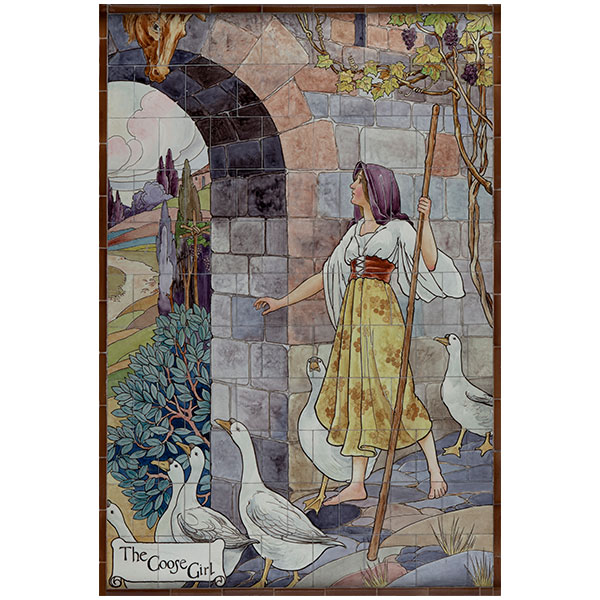
Doulton Goose Girl Tile Panel at MAACM
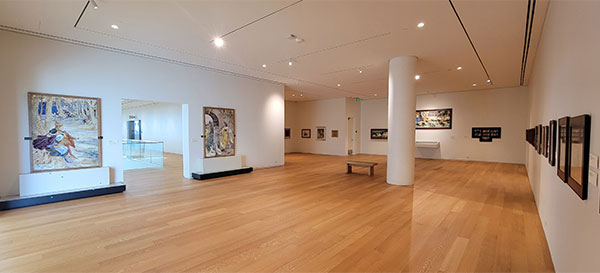
Doulton Tile Panels in the Children's Gallery at MAACM
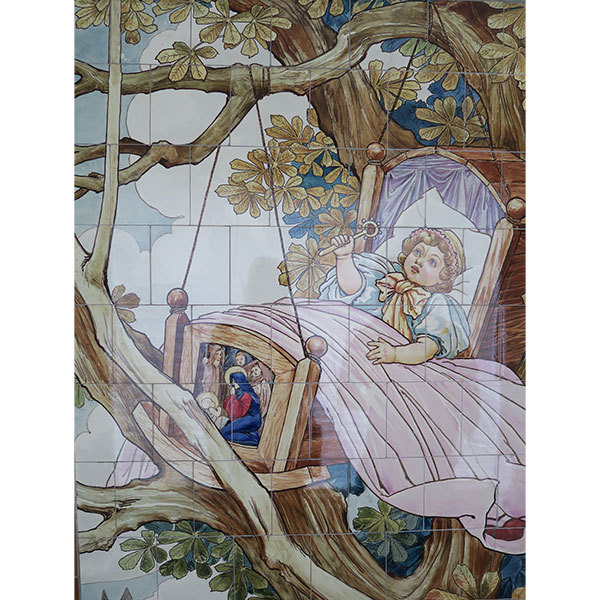
Doulton Hush-a-Bye Baby detail

St. Thomas' Hospital Seymour Ward 1910

St. Thomas' Hospital Seymour Ward
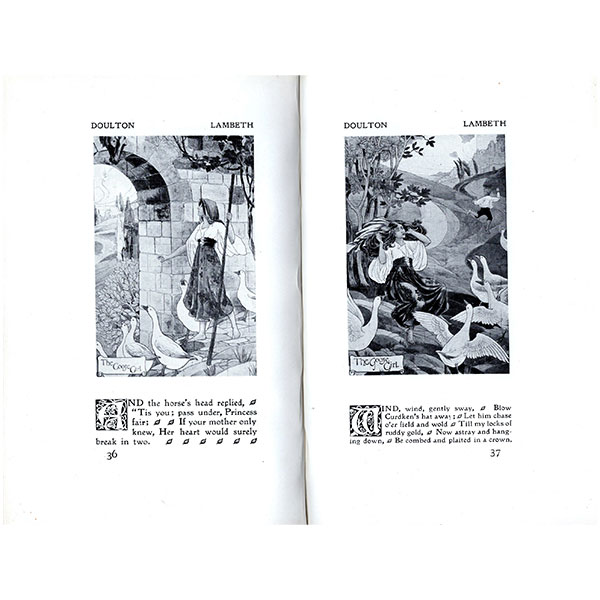
St. Thomas' Hospital Goose Girl Seymour Ward from Pictures in Pottery
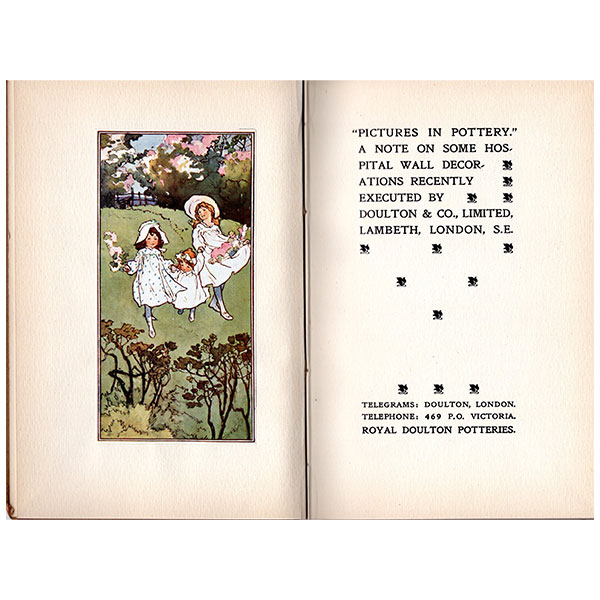
Royal Doulton Pictures in Pottery
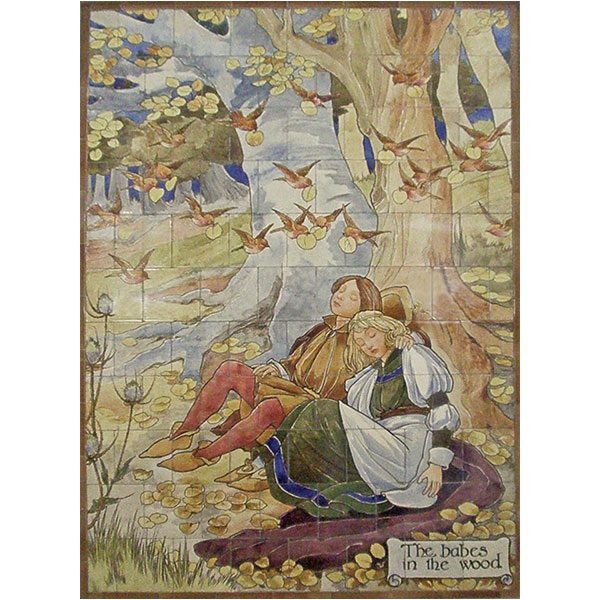
Doulton Babes in the Wood from St. Thomas' Hospital Seymour Ward

Hush-a-Bye Baby Watercolor photo by P. Dunn
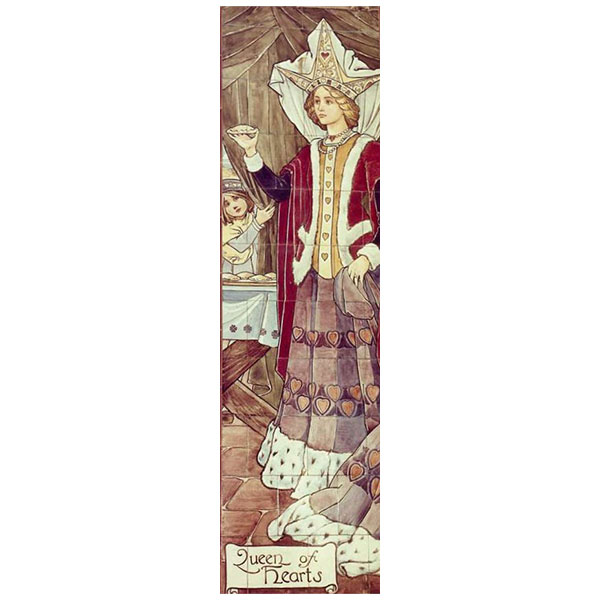
Doulton Queen of Hearts Tile Panel from St. Thomas' Hospital Seymour Ward
